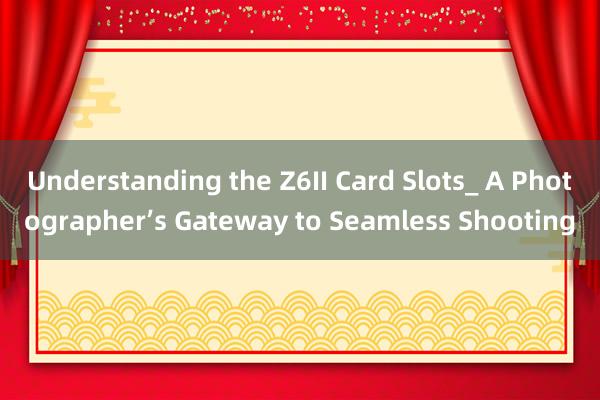Understanding the Z6II Card Slots_ A Photographer’s Gateway to Seamless Shooting

The Nikon Z6II Card Slots – An Overview of Dual Storage Excellence

The Nikon Z6II, one of the most popular mirrorless cameras among professional photographers, boasts a powerful feature that enhances both performance and workflow: dual card slots. While many cameras come with a single card slot, the Z6II sets itself apart with two versatile card slots that provide numerous benefits for photographers, videographers, and content creators alike. In this section, we will explore the importance of these dual card slots, how they work, and why they make the Z6II a standout choice for serious photographers.
Dual Card Slots: More Than Just Redundancy
One of the primary advantages of having two card slots is redundancy. Imagine you’re out on a crucial photo shoot, capturing once-in-a-lifetime moments. The last thing you want is for your memory card to fail, causing you to lose important images. With dual card slots, this risk is significantly reduced.
The Z6II supports two types of memory cards: SD cards (UHS-II) and CFexpress Type B cards. This combination of card slot options gives users a level of flexibility and security that is unparalleled. When one card fills up, the camera automatically switches to the second card, allowing for uninterrupted shooting. Alternatively, you can configure the camera to record different files to each card, offering the ability to store high-resolution images on one card while saving video footage or backup files on the other.
Moreover, if one of the cards encounters an error or corruption, the second card serves as a backup. This redundancy ensures that your work is safe, offering peace of mind in critical situations. It’s a feature especially favored by professional photographers who cannot afford to lose a single shot, whether they are covering weddings, live events, or high-stakes sports competitions.
Flexibility and Speed: SD and CFexpress Compatibility
The flexibility in card choice is another highlight of the Z6II’s dual card slots. The first slot supports SD cards, specifically the UHS-II (Ultra High-Speed) format, which offers fast read and write speeds for most types of photography. UHS-II cards are ideal for shooting high-resolution still images, as they provide fast transfer speeds that ensure the camera operates efficiently and reliably.
The second slot, however, is designed for CFexpress Type B cards, a relatively new and advanced card format that is capable of even faster speeds. These cards are essential for video recording in 4K and higher resolutions, particularly in formats like ProRes or RAW. When paired with the Z6II, xxx viet nam hd CFexpress cards provide the performance necessary for high-bit-depth video and rapid burst shooting without compromising on performance or risk of buffer delays.
For photographers who work in both stills and video, xxxx thai lan having these two card types available gives them the best of both worlds. For example,phim sex việt nam địt nhau cực mạnh a wedding photographer may choose to save photos on the SD card and videos on the CFexpress card to ensure optimal performance and file management. Or, during a wildlife shoot, you may want to have high-speed continuous shooting on the CFexpress card while saving backup images on the SD card.
Customizable Workflow for Every Shoot
The dual card slots on the Z6II also offer customizable recording modes that make workflow smoother. Depending on the photographer’s needs, the camera can be set to record in a range of ways, including:
Overflow Mode: As one card fills up, the camera seamlessly switches to the second card, ensuring that you never run out of space during a shoot. This is particularly useful during long events or when shooting in remote locations where you may not have the opportunity to change cards frequently.
Backup Mode: The Z6II can be set to simultaneously record the same data onto both cards. This is a great option for photographers who want to ensure their work is doubly safe and backed up in real time. For example, if you are capturing a rare event or a client’s special moments, it’s reassuring to know that two copies of each image are being recorded.
Separate Modes: This mode allows you to assign different types of data to each card. For instance, you can save high-quality stills to the SD card while saving video footage or time-lapse sequences to the CFexpress card. This can make managing your data post-shoot much easier, as it keeps different file types neatly organized.
Speed and Efficiency
When it comes to high-end photography, speed is of the essence. The Z6II’s dual card slots provide increased efficiency by offering faster read and write speeds, particularly when using the CFexpress card in the second slot. With the Z6II’s ability to handle large file sizes and high burst rates, especially in continuous shooting mode, photographers can rest assured that they won’t miss a single shot due to memory limitations. Additionally, the ability to offload images more quickly through both slots enhances post-production workflow, saving valuable time when it comes to file transfers and processing.
go88 playMaximizing the Potential of Z6II Card Slots – Advanced Features and Real-World Applications
The Nikon Z6II’s dual card slots not only provide an essential layer of security but also offer a wide array of advanced features that enhance the overall shooting experience. In this section, we will delve deeper into some real-world applications of these card slots and how they benefit both amateurs and seasoned professionals.
High-Speed Burst Photography: No Compromises
For sports photographers, wildlife photographers, and anyone who needs to capture fast-moving subjects, the Z6II’s dual card slots offer a significant advantage. The CFexpress Type B card in Slot 2, with its ultra-fast write speeds, allows the camera to sustain rapid burst rates without buffering. This means that you can shoot hundreds of frames in quick succession, and the camera will continue to perform without slowing down. Whether you’re photographing a bird in flight or a soccer player making a crucial goal, the Z6II’s dual card slots ensure that you’ll never miss that decisive moment.
Moreover, when shooting in Continuous High mode, the Z6II can use both slots to their fullest potential. For example, the first slot may be used to record the high-resolution RAW files, while the second slot handles JPEG versions or video files, giving you maximum flexibility in capturing every nuance of the scene.
Video Recording Excellence: No Compromises on Quality
In the world of professional videography, especially for those who shoot 4K or 8K footage, card speed and reliability are paramount. The Z6II delivers incredible video performance with both internal 4K recording at 60p and the ability to shoot 10-bit 4:2:2 HDMI output. For videographers who rely on high-quality video capture, having CFexpress cards in Slot 2 is a game-changer. These cards provide the high data transfer rates necessary for recording high-quality video with minimal risk of dropped frames or data corruption.
The dual card slots also enable the Z6II to be used for longer video shoots, as the camera can continue recording on the second card once the first one is full. The ability to seamlessly switch between cards allows filmmakers to maintain uninterrupted shooting for extended periods of time, whether for documentaries, commercials, or live events.
Professional Data Management: Streamlined Workflow
Another benefit of the Z6II’s dual card slots is the ability to streamline data management. For photographers and videographers who work with large volumes of data, keeping everything organized is essential. With the option to assign different file types to each card, you can easily separate still images, video footage, and backups. This helps to keep everything in its proper place and minimizes the risk of accidental overwriting or losing files.
Furthermore, transferring data from two cards simultaneously can speed up the post-production process. Many professional photographers and filmmakers work in fast-paced environments, where time is of the essence. With the Z6II’s efficient card slots, you can upload and offload files from both cards at the same time, significantly reducing the time spent on data management and getting your work ready for editing faster.
Real-World Case Studies: Z6II’s Card Slot Performance
Several photographers and videographers have praised the Z6II for its exceptional performance in real-world scenarios. For instance, a professional wedding photographer who shot with the Z6II during a high-profile wedding noted how the dual card slots allowed for peace of mind when shooting important moments. With the camera simultaneously recording images on both cards, there was no need to worry about a failed memory card ruining the shoot.
Similarly, a wildlife photographer who used the Z6II during a remote shoot in Africa appreciated the card overflow functionality, allowing them to keep shooting continuously without needing to swap cards in the middle of a critical moment.
Conclusion
The dual card slots of the Nikon Z6II provide a wealth of benefits that elevate the camera to a higher level of reliability, versatility, and performance. Whether you are a professional photographer working on a tight deadline or a videographer creating high-quality content, these card slots are designed to enhance your workflow and ensure that your memories and work are captured with confidence. With the combination of SD and CFexpress cards, the Z6II caters to both fast-paced stills and demanding video shoots, offering you peace of mind with every shot.






